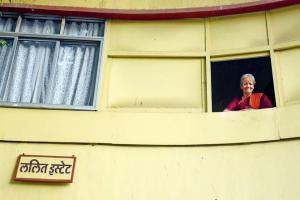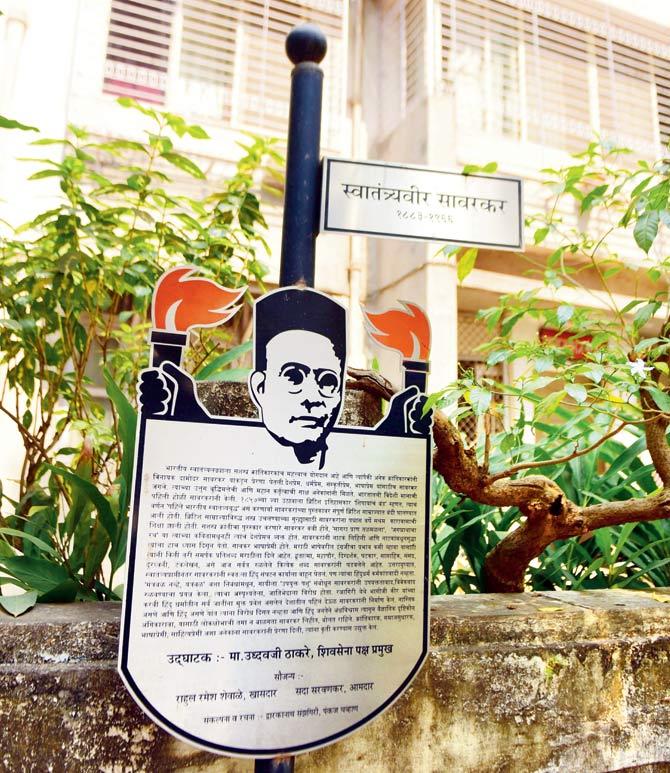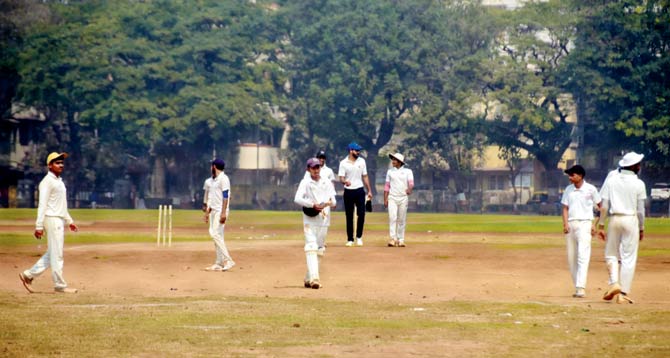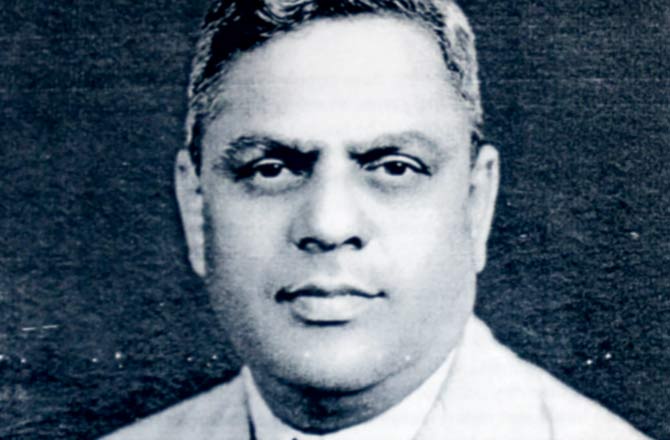Author-critic-translator Shanta Gokhale's new book is a biography on Shivaji Park, the neighbourhood that inspired her to pick up the pen, and secretly dance in her room

Shanta Gokhale at her residence, Lalit Estate, on SH Paralkar Marg where she has lived since she was two years old. Pic/Rane Ashish
The veranda at author and cultural chronicler Shanta Gokhale's home, Lalit Estate, boasts a little bend, which from the outside, looks like an exaggerated curve, giving the 80-year-old Art Deco-inspired structure on Shivaji Park, an edge over the rest. It was just a year old, and Gokhale all of two, when her parents moved into this developing middle-class neighbourhood. Shivaji Park, at the time, was still an experiment—an attempt to decongest the native town, where chawls were in abundance and privacy, scarce. The shift to a block, where "you were not supposed to know what was cooking in your neighbour's kitchen," did meet with some resistance. But gradually, the new way of life prevailed. Gokhale's new book, Shivaji Park, Dadar 28: History, Places, People (Speaking Tiger), is a 150-page sketch on the neighbourhood she calls home.
The spatial biography is not meant to make you nostalgic about old and vanishing urban pockets in the city. Instead, Gokhale trains her journalistic lens to trace the story of the neighbourhood's birth, evolution and contribution to the city's social, political and cultural framework. As a resident,
she only makes this experience more personal.
ADVERTISEMENT

Hindu nationalist and writer Vinayak Damodar Savarkar was also a resident of Shivaji Park
Her own lane has lived different lives, in her lifetime. When Lalit Estate came up in 1940, the stretch was called Bhandarwada Road, after the Bhandaris of the area, who were engaged as toddy tappers. "The entire section beyond my building was a wadi, with little cottages that belonged to them. One of the residents from there, a woman named Rukmini, used to come home and bathe us. My mother was busy then—she started her matriculation and college after she had us. Since Rukmini required work, she became our bather. She also connected us to the people living in the wadi," shares Gokhale.
The road was metalled in the 1960s, and renamed after architect Shankarrao Harishchandra Paralkar. The cottages slowly made way for structures that identified more with the grace of Lalit. Post liberalisation, when residents had money to dispose, it began to show in everything, including the size of the Ganpati and the number of instruments one could employ, during Ganeshotsav. Gokhale remembers one particular procession that stopped right outside her building. "In the early days, I would go and stand at the veranda, and glare at them, thinking that somebody would look up, and take it as a sign to move on. But no such thing happened. I even tried to complain on the helpline. After those first, few attempts, I thought, let me dance along. If you can't beat them, you join them," she says. "So, [as soon as they arrived] I would put aside all my work, and swing away in my room, till they left," she adds, laughing.

The ground at Shivaji Park, says Gokhale, in keeping with its "democratic nature" has continued to serve many purposes - recreation, sports, prayer and politics. Pics/Bipin Kokate
If there is one person that Shivaji Park owes its town planning vision to, it was city engineer Narayan Vinayak Modak (1889-1971), who once occupied Udyam, a bungalow that is stone's throw from Gokhale's home. In the book, his nephew, Dr Prasad Modak, tells Gokhale how the housing plots on Dr MB Raut Road, were deliberately staggered, "to ensure free flow of air from the park to the homes". Modak is also credited with building Dadar's sewage and sewerage plant.
Homes were designed such that the toilets would be inside the house, and with at least two doors—one for the residents, and the other on the landing, from where the sweeper would enter and clean them. "Then, the caste system was so strong and rigid that most people didn't want the sweepers walking into your living quarters," she recalls. Gokhale's parents only adhered to this, because of the elderly in the family, for whom the "practice was important". That door, in her house, has long been shut.

Late city engineer Narayan Vinayak Modak, who once lived in Udyam, a bungalow that is stone's throw from Gokhale’s home, was instrumental in planning the neighbourhood.
Gokhale also meticulously maps out the ground at Shivaji Park, and how, in keeping with its "democratic nature", it has continued to serve many purposes—prayer, recreation, sports and politics.
For the longest time, Shivaji Park was also the cultural hotbed of the city. The names that dotted the city's arts, literature and theatre scene, had found an address here. Gokhale says that this also left an indelible impression on her, influencing her career. "We were living in a space where music was a passion for a lot of people, so was dance and theatre. I remember seeing two amazingly significant plays at the hall in Bal Mohan School. This was much before we even had a dedicated theatre space. And if you walked down Shivaji Park, you would invariably hear the sound of ghungroos, because girls were learning kathak or bharatanatyam." Today, it's zumba and not the classical arts, that seem to interest the residents.
The neighbourhood has been the battleground of politics since the Samyukta Maharashtra movement, where Bal Thackeray's father Keshav Sitaram Thackeray, another famed resident, brought "assorted parties" under one umbrella to fight the common cause of keeping Maharashtra together. So did his son with his cartoons, and the charismatic PK Atre with his editorials and speeches. The 1992-93 riots, however, was the first time, when Gokhale, says, she sensed a schism develop in her neighbourhood. "Divisions always existed, but they weren't exacerbated. But when the riots happened, the Irani restaurant on the corner [of our lane] called Light of Bharat, run by an Irani family, was burned down. A mob from outside [not Shivaji Park residents], hauled out all the furniture in the place and made a bonfire of it. It was sad and scary." On the surface, she says, Shivaji Park has healed. "But the cracks that appeared then, have deepened," she feels.
Until some years ago, residents were up in arms against the "heritage precinct" status given to the area. The government eventually decided to restrict the Grade I heritage tag to the park, but are yet to arrive at a decision. "This is active encouragement to the builders lobby," Gokhale thinks. "While I would love this place to remain [as is], we have to face the fact that more people are coming into the city, and have to be accommodated. I guess, every generation looks back with nostalgia, at how it [a place] was, but you can't hold on to it."
For Gokhale though, home is still beautiful. "Growing up here, we had a great sense of freedom, and surely that wasn't just because our family was liberal, it was also because the space was that open, and people of all classes came here. It wasn't just the stuffy middle class." On December 6, when thousands of people throng Chaityabhoomi, to pay their respects to Dr BR Ambedkar, Gokhale makes it a point to stroll through her neighbourhood. "I go out just to see what the rest of the country looks like. I can hear languages that I haven't heard, and see physiognomies that I haven't seen. It's a time, when I can be in touch with India. It's a moving experience."
Catch up on all the latest Mumbai news, crime news, current affairs, and also a complete guide on Mumbai from food to things to do and events across the city here. Also download the new mid-day Android and iOS apps to get latest updates
 Subscribe today by clicking the link and stay updated with the latest news!" Click here!
Subscribe today by clicking the link and stay updated with the latest news!" Click here!







